BOD Testing Accuracy and Success
Biochemical oxygen demand, BOD, measures the amount of oxygen consumed by microorganisms when decomposing organic matter. BOD also measures the chemical oxidation of inorganic matter (i.e., the extraction of oxygen from water via chemical reaction). The BOD test used to measure the amount of oxygen consumed by these organisms can occasionally give operators some trouble.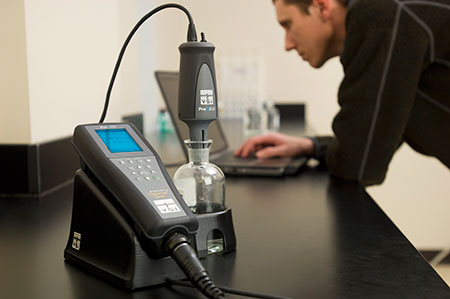
The BOD5 test consists of an initial and final DO reading. There are several factors that can affect accurate initial and final readings. For the greatest success in your BOD test, ensure that the probe is cared for and used properly, the instrument is properly calibrated, and good lab practices are always followed.
Continue reading as we address some common problems that are encountered when conducting BOD testing. There can be confusion about BOD and its relationship with dissolved oxygen (DO) readings. Even though the end result of BOD testing is a final BOD reading, the calculations are all based on DO readings. Therefore, DO readings must be as accurate as possible to ultimately get accurate BOD results.
Electrochemical Dissolved Oxygen Sensors
Sensor Theory
Briefly, the electrochemical technology utilizes a gold cathode, silver anode, electrolyte solution, and Teflon® or Polyetheylene (PE) membrane in order to create a potential across the membrane. The oxygen molecules are consumed at the gold cathode after a voltage is applied from the silver anode. In essence, the diffusion rate of oxygen across the membrane is measured. (Learn more about membrane types, Dissolved Oxygen Meters - Which Membrane Type Should I Use?)
The sensors do not measure the concentration of oxygen but, instead, the sensor measures the partial pressure of dissolved oxygen in % saturation. We know this because water can hold more oxygen in freshwater than in seawater, however, the sensor's raw output signal is identical in both media since the pressure is identical in both media.
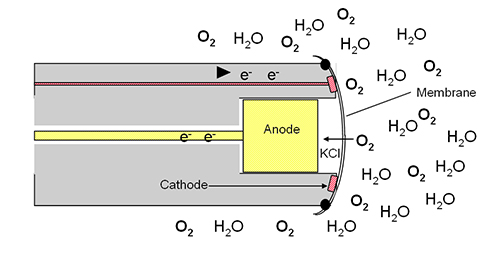
Figure 1. In electrochemical sensors, O2 molecules diffuse through the membrane to the sensor at a rate proportional to the pressure difference across it.
The instrument then calculates the concentration from the % saturation value (pressure value), the sample temperature, and a measured or entered salinity correction value. The calculation is based on the Oxygen Solubility chart found in Standard Methods. The instrument software automatically calculates the mg/L values.
For more in-depth information about dissolved oxygen, please visit the YSI DO page. For more information on BOD, please visit the YSI BOD page.
There are several factors that can affect DO readings, including probe care and use, calibration techniques, and other laboratory practices. At some point, many labs, if not all, have some issue with their BOD results from blanks coming out too high or poor glucose-glutamic acid (GAA) results. The steps in correcting these issues can often be numerous, time-consuming, and outright frustrating. One easy step to take out of the equation is the functionality of the instrument and probe.
Electrochemical technology includes both polarographic and galvanic sensors.
Accuracy: typical electrochemical sensors have an accuracy spec of +/-0.2 mg/L. Be sure to review the system spec if comparing products. Some manufacturers only state the instrument spec without the probe/cable. YSI provides the system spec since the probe can't be used without the cable.
Stirring: electrochemical sensors require stirring of the sample in order to overcome the consumption of oxygen at the membrane’s surface. The polarographic BOD probes have a built-in stirrer to provide sufficient flow past the membrane to provide accurate readings. The optical BOD probes have a stirrer to improve the response time. Stirring also ensures a representative sample in the bottle.
(Learn more about how flow affects DO readings, DO Meter Measurement Problems? Check Out These Top Tips!)
Maintenance: the membrane needs replaced approximately every 2-8 weeks and the anode and cathode need occasional maintenance (sanding and/or soaking) in order to provide optimal performance, stability, and accuracy.
Warm-Up Time: the YSI BOD probes that use polarographic sensors, require a period of time to warm-up before using. In order to save the working life of the probe, it is recommended that the instrument be turned off overnight but this will require a warm-up time between 5-15 minutes in the morning before the probe and instrument can be calibrated.

Probe Use and Care
In order for your DO reading, and ultimately your BOD result, to be as accurate as possible the following issues surrounding the use and care of the probe must be addressed.
1. The electrolyte solution should be fresh. Once it has been hydrated, the shelf life of the solution is one year. (Learn more, YSI Calibration Solutions and Buffers Expiration Times).
It is best to allow the electrolyte solution a full 24 hours after mixing before first use to ensure proper mixing of the solution. Care should also be taken to ensure that the correct solution is being used for the correct membrane. The solution you use for your field DO probe may not be the same solution needed for your lab BOD probe and vice versa. Follow the instructions on the electrolyte bottle or download the membrane selection guide.
2. Membranes must be installed correctly. Bubbles, wrinkles, and obvious tears and/or holes can create problems. However, occasional cosmetic blemishes of the membrane are normal and generally do not affect the successful operation and functionality of the probe. The cap membranes rarely have any issues when stored and used properly.
Membrane caps are a much easier option than the stretch-over style membranes common on older DO field probes. The cap membranes have been available for years and are capable of being changed within seconds. Some manufacturers may try to state that membrane changes are costly and cumbersome but it’s as simple as unscrewing the old cap and screwing on a new one. Proper membrane cap installation is shown below in Figure 2 and in the short video clip.
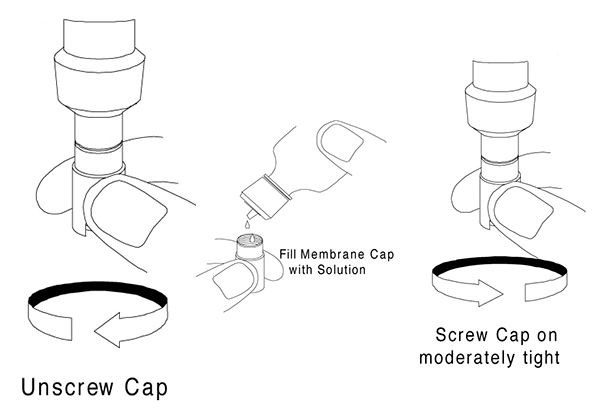
Figure 2. Installing a cap membrane couldn’t be easier. Unscrew the old cap and discard. Fill the new cap a little less than halfway with solution. Screw the cap onto the sensor and rinse off any extra solution.
3. The gold cathode should be bright and have fine scratches covering the entire surface (See Figure 3). Do not attempt to create a “glass smooth” surface on the cathode, because the absence of scratches will prevent accurate readings from being measured. The gold cathode can also become plated with silver from the anode and tarnished from use with wrinkled membranes or after having contact with known interfering gases such as hydrogen sulfide.
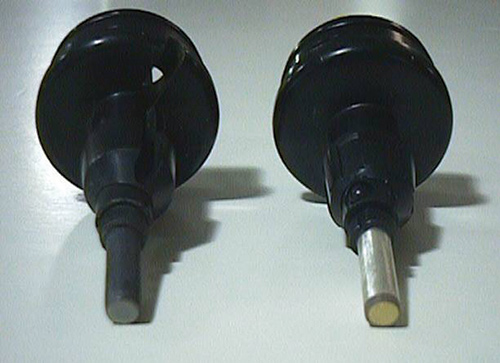
Figure 3. On the right are a properly prepared cathode and anode. Note the light silver appearance of the anode and the matte finish of the gold cathode.
In order to service the gold cathode, follow the instructions below using the sanding disk provided in the Cap Membrane Kit that was included with your YSI BOD probe.
Instructions for Texturing the Gold Cathode
The cathode (gold circle) on most YSI probes can be restored to its normal polish by wet sanding the electrode. To sand the cathode, place a 400 grit wet/dry sanding disc, face-up in the palm of your hand. Next, touch the cathode to the sanding disc and twist the probe 3-4 times on the disc. After sanding, rinse the electrode with clean water and inspect to see that the original matte finish is restored. (The gold cathode should have many fine scratches on the surface.) If the cathode remains tarnished it may need to be returned to YSI for service.
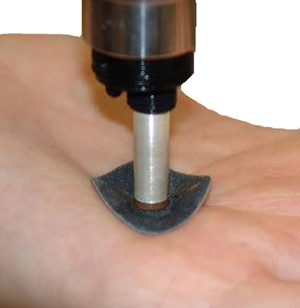
Figure 4. The gold cathode being sanded with a 400 grit wet/dry sanding disc to properly texture the cathode.
NOTE: It is very important for the gold cathode, on any probe with cap membranes, to have the proper finish. The YSI 5905 and 5010 BOD probes are included in this category. The cap membrane probes are more sensitive to improper cathode finishing than the field probes. Do NOT use a pencil eraser to clean the gold cathode.
Always install a new membrane with fresh electrolyte solution after servicing the electrodes and allow the probe to stabilize before calibration.
Instructions for Cleaning the Silver Anode
The silver anode, from which the current is sent out, should be light in color or silver-looking (see Figure 3). A dull, tarnished anode can result in inaccurate readings due to the resultant lower probe current. Some dissolved oxygen instruments may indicate this problem by displaying an error message during calibration.
In the past, a typical practice was to leave the dissolved oxygen instrument turned on overnight. However, the entire time the instrument is turned on it is sending voltage through the anode and the life of the probe is being unnecessarily reduced. The dissolved oxygen instrument should be turned off after use in the evening and powered up in the morning, allowing the instrument enough time to warm up and stabilize before calibration.
The anode may periodically need “cleaning” or servicing in order to remove the tarnish that appears. The tarnish results from wrinkled or loose membranes, interfering gases, and heavy probe usage. The time period required between anode cleanings depends on the different uses and applications.
However, one should only clean the anode when it is absolutely necessary, and avoid cleaning too frequently. The probe can operate perfectly well even with a tarnished look. This is important to understand - the probe can operate perfectly fine even with a "dirty" looking anode! When you begin to have difficulty calibrating, or experience drifting, jumpy readings, first change the membrane to eliminate the membrane and solution as the cause. Then, if still necessary, clean the anode following the instructions below.
1. To physically clean the electrodes on the DO membrane cap-style probes, you can wet sand the anode with 400 grit sandpaper. Simply wrap the sanding disc around the anode (silver portion making up the shaft of the sensor) and, in a helical fashion, twist the sanding disc down and around.
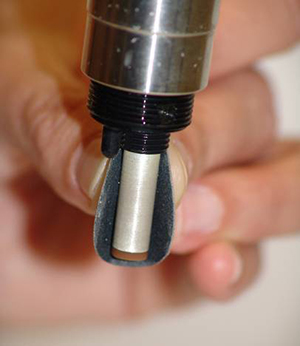
Figure 5. The silver cathode being sanded with a 400 grit wet/dry sanding disc to properly clean the anode from build-up and tarnishing.
2. To chemically clean the electrodes, soak the probe (without the membrane) in a 14% Ammonium Hydroxide solution for 2-3 minutes. A solution of 3% can also be used (household cleaners with ammonia are about 3%) to soak the probe overnight. After soaking, rinse the probe EXTREMELY WELL under running tap water for 4-5 minutes. (You can smell the probe tip to make sure there is no residual ammonia left). Then rinse with deionized water, rinse with KCl electrolyte solution, and install a new membrane using fresh KCl solution. You may also want to physically clean the anode with the sanding disc after the ammonium soak.
Dissolved Oxygen and Temperature
DO values are based on temperature compensation, so it is crucial for the temperature readings of your probe to be accurate. Although it rarely occurs, if a thermistor goes out of tolerance, your temperature readings will be obviously incorrect. Temperature effects DO readings in several ways.
First, it changes the permeability of the membrane itself. As the temperature increases, the permeability of the membrane also increases. As the temperature decreases, the permeability of the oxygen through the membrane decreases.
Secondly, temperature affects the amount of oxygen that can be dissolved in water. As the temperature increases, the oxygen saturation of the water decreases. Since YSI’s dissolved oxygen instruments have automatic temperature compensation, it is important to occasionally check the instrument’s temperature accuracy. (Learn more, DO Meter Measurements Problems? Check Out These Top Tips!).
Calibration
The next most common problem happens during calibration. An incorrectly calibrated instrument will result in incorrect DO readings.
The effects of an improperly calibrated instrument can result in odd values - high or low. It can also result in DO values of your blank water being “higher” on day 5 than on day 1. YSI encourages an air-saturated calibration procedure for DO probes and instruments. Compensating for altitude or barometric pressure is also important and all of YSI’s instruments have the capability of compensating. Your data is only as good as your calibration.
1. Read the Operations Manual that is provided with both the YSI Dissolved Oxygen Instrument and the probes.
2. Allow proper warm-up time for the instrument. This is especially important for new membranes and probes. New membranes need a short “break-in” period of approximately 30 minutes before taking readings. A new probe should be “broken-in” overnight.
3. Allow the temperature in the bottle time to equilibrate with the room temperature if there is a large temperature gradient.
4. Compensate for altitude or barometric pressure. Note that calibrating using only altitude does not account for local weather conditions. Weather variations are typically +/- 1% from week to week. Extreme weather can cause variations up to four times larger. If it was clear and sunny under a high-pressure system when the initial DOs were taken, then altitude calibration can cause all readings that day to be off about 1%. Conversely, if it is rainy under a low-pressure system when the final DOs are read, then all readings that day may be off about 1% in the other direction. The additive effect in this scenario is 2%, and 2% of 9 mg/L is 0.18 mg/L! This value approaches or exceeds the error budget for this method and does not account for any degree of accuracy on the system! Remember barometer readings received from the local airport are usually corrected for sea level. Inches of mercury multiplied by 25.4 will result in mm of mercury. You must then determine the true barometric pressure. An approximate formula for this “uncorrection” is below:
True BP = [corrected BP mmHg] - [2.5 x (local altitude in ft. above sea level)/100]
Several instruments have internal barometers so you may have to occasionally verify that the internal barometer is reading accurately and calibrate it only if needed.
5. Calibrate in a 100% saturated air environment. Make sure there are no water droplets on the membrane. Water on the membrane during air calibration will cause a low calibration reading due to the oxygen in the droplets being consumed. Excess water may be removed by shaking the probe or dabbing them with a laboratory-grade cleaning tissue.
In addition, make sure the calibration environment is clean. Change the water in the BOD bottles occasionally and use a clean bottle. Using water in the calibration bottle that has “stuff” growing in it will not yield consistent calibrations. See Figure 6.
6. One successful calibration per day is all that is needed. Avoid multiple or back-to-back calibrations.
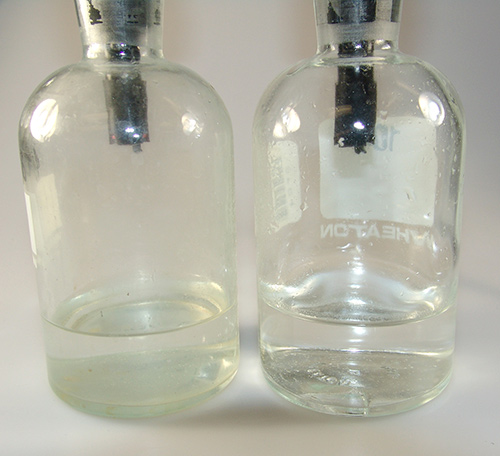
Figure 6. The calibration bottle on the right is clean. The calibration bottle on the left actually has algae growing in it which could affect the calibration values.
Optical Dissolved Oxygen Sensors
Sensor Theory
Briefly, this technology utilizes optical, luminescence in order to determine dissolved oxygen values. The optical field probes and OBODTM laboratory BOD probe both work in the same manner.
The optical DO probe measures dissolved oxygen by emitting blue light of the proper wavelength that causes the sensing element to luminesce, or glow red. Oxygen dissolved in the sample continually passes through the diffusion layer to the luminophore layer, affecting the luminescence in both intensity and lifetime. The YSI sensor measures the lifetime of the luminescence as it is affected by the presence of oxygen with a photodiode (light detector) in the probe and compares that reading to a reference. See figure 7.

Figure 7. Oxygen is constantly diffusing through the paint layer, affecting the luminescence of the sensing layer.
To increase the accuracy and stability of the measurement, the sensor also emits a red light that is reflected by the dye layer back to the photodiode in the sensor. The sensor measures the reflected light and uses that reading as the reference value for comparison to the previously measured lifetime luminescent value. The lifetime of the luminescence from excitation by the blue light is compared to that of the reference value (red light) and a stable dissolved oxygen concentration is calculated by the probe.
Although the accuracy of an optical sensor’s measurement is not dependent on flow, the YSI ProOBODTM optical BOD probe does have a stirrer. This stirring ensures a truly representative sample in the BOD bottle and YSI scientists have determined that flow improves the optical sensors response time.
There are several factors that can affect DO readings, including probe care and use, calibration techniques, and other laboratory practices. At some point, many labs, if not all, have some issue with their BOD results from blanks coming out too high to poor GAA results. The steps in correcting these issues can often be numerous, time-consuming, and outright frustrating. One easy step to take out of the equation is the functionality of the instrument and probe.
Choosing the right sensor/technology for measuring dissolved oxygen (BODs) depends mainly on the preference of the laboratory personnel. Optical, luminescent technology is gaining wider acceptance over traditional electrochemical (membrane-covered) sensors due to several factors.
Accuracy: optical sensors are more accurate than membrane-covered sensors. This benefit is realized with your blanks. Optical DO sensors have an mg/L accuracy of +/-0.1 mg/L greatly improving the chances of blanks not exceeding the +/-0.2 mg/L threshold level.
Stability: YSI sensors measure the lifetime of the luminescence as it is affected by the presence of oxygen with a photodiode in the probe and compares that reading to a reference. What this means for you is a more stable DO reading calculated by the probe based on a highly stable reference.
Maintenance: optical technology eliminates the need for membrane replacements and anode and cathode maintenance. Even though cap membranes only take seconds to change, they can still cause issues if done improperly. In addition, since optical sensors don’t have anodes or cathodes there is no sanding or soaking required. The optical sensor only requires that its sensor cap be replaced every 12-18 months. The YSI OBOD probe has a protective sensor guard to prevent the paint layer from being scratched when moving from BOD bottle to BOD bottle.
Stirring: even though optical sensors don't consume oxygen and therefore don't require stirring to get an accurate reading, the YSI optical BOD probes have a built-in stirrer to provide a representative sample in the bottle and improve the response time. YSI scientists have verified that stirring does improve DO data response times which may be important if taking a lot of BOD readings.
Approval: EPA approval of changes made to ASTM D888-09 include the addition of Test Method C, which approves the use of luminescence-based optical sensors for dissolved oxygen measurement for all EPA-regulated NPDES, BOD, and CBOD measurements. The YSI OBOD (optical BOD probe) is an EPA approved methodology. (See blog What Does an EPA Approved Method Really Mean?).
(Learn more, on-demand webinar, Introduction to YSI's Optical BOD Probe).
Probe Use and Care
In order for your DO reading, and ultimately your BOD result, to be as accurate as possible the following issues surrounding the use and care of the probe must be addressed.
1. Clean the probe and sensing element. In order to clean the optical DO sensors, rinse them with clean water and wipe them with a lint-free cloth. If necessary, use a mild detergent. Do not use alcohols or other organic solvents that may deteriorate the sensing element.
2. The sensing element should be replaced about once per year but may last longer. It should also be replaced if it is cracked or damaged. While changing the sensing element, rinse the optics with clean water and then wipe the optics with a lint-free cloth or lens tissue. The instruction sheet that is shipped with the replacement sensing element includes calibration coefficients specific to the sensing element. For the highest accuracy, these coefficients should be entered by the user into the instrument following the instructions provided.
Dissolved Oxygen and Temperature
DO values are based on temperature compensation, so it is crucial for the temperature readings of your probe to be accurate. Although it rarely occurs, if a thermistor goes out of tolerance, your temperature readings will be obviously incorrect and you may need to replace the sensing portion of your OBOD probe.
Temperature affects the amount of oxygen that can be dissolved in water. As the temperature increases, the oxygen saturation of the water decreases. Since YSI’s dissolved oxygen instruments have automatic temperature compensation, it is important to occasionally check the instrument’s temperature accuracy.
This temperature dependence is removed by proprietary algorithms in the system software. As for any oxygen probe, the mg/L concentration is calculated from the sensor’s % saturation reading, temperature, and salinity after calibration of the system using barometric pressure.
Calibration
The next most common problem happens during calibration. An incorrectly calibrated instrument will result in incorrect DO readings.
The effects of an improperly calibrated instrument can result in erratic readings including unstable, jumpy, or odd values. It can also result in DO values of your blank water being “higher” on day 5 than on day 1. YSI encourages an air-saturated calibration procedure for DO probes and instruments. Compensating for altitude or barometric pressure is also important and all of YSI’s instruments have the capability of compensating.
1. Read the Operations Manual that is provided with both the YSI Dissolved Oxygen Instrument and the probes.
2. Inspect. Visually inspect the sensor cap for biofouling or large scratches. Biofouling could consume or produce oxygen thereby affecting the calibration. Large scratches in the paint surface could affect the calibration as well.
3. Ensure there aren’t any water droplets on the sensing element or thermistor and dab them off or shake them off if there are. Also, ensure that the temperature is stable - since you are in the laboratory this should already be good.
4. Compensate for altitude or barometric pressure. The Pro Series and all MultiLab instruments have an internal barometer. They will automatically use this value as part of the calibration routine.
5. Compensate for salinity. This is the value of the water you will be testing. Make sure the salinity value is set to the value of the samples in the BOD bottles. If this value is 0 then you can set it the first time and forget it.
6. Calibrate in a 100% saturated air environment. The calibration should take place in the air in the BOD bottle and not submerged in the water in the bottle.
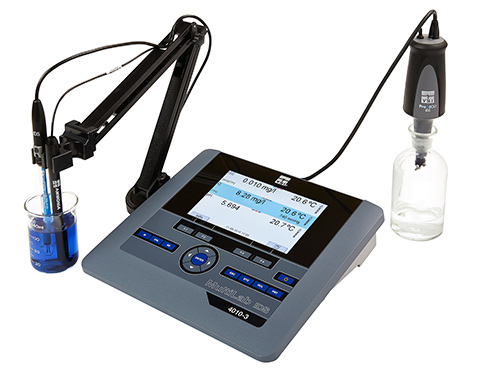
Figure 8. The YSI MultiLab 4010-3 can measure DO with an OBOD sensor, pH, temperature, ammonia, and many other parameters. The instrument also features a built-in barometer.
Data Troubles
When encountering a problem with BOD values, most operators blame the instrument or probe first. After all, it’s what gives you the values! There can be many factors leading to the problem from dirty BOD bottles, DI water, bad seed, bubbles, non-linearity, and so on.
Calibration: Regardless of technology, it is recommended to only calibrate the instrument once a day before readings are taken. Make sure there are no water droplets on the probe tip before calibrating and that the probe is in a 100% water-saturated air environment. A BOD bottle with a little water in the bottom is all that’s needed. Place the probe back in this bottle when not in use. Make sure this bottle is kept clean as shown in the bottle on the right of the image. As shown in Figure 6, the bottle on the left is not a clean environment and could affect the calibration.
Probe Care: Polarographic sensors must have fresh electrolyte and membranes along with a maintained anode and cathode for optimal performance. Optical sensors will need an occasional visual check of the paint layer on the sensor cap.
Warm-Up Time: Polarographic probes require sufficient warm-up time of 5-15 minutes before calibrating and using the probe. Improper warm-up time can easily lead to data drifting due to an inaccurate calibration. Optical probes do not require a warm-up period.
Other Factors Affecting DO Readings
There are other factors that may affect your BOD readings or your blanks. Please consider the following:
Cleanliness. Cleanliness can be very difficult to track. This is usually what most labs begin to examine when they have blank depletions coming out too high. Many items could be dirty including the water itself or anything that comes in contact with the water from the time it comes out of the still until its final DO is measured.
Supersaturation. DO may out-gas during the five days giving artificially high depletions and BODs. This is most common with cold river water samples collected during the winter. They may not have been supersaturated in the field, but become supersaturated when they warm up in the lab. A BOD test cannot begin with a supersaturated sample. This limits the total DO available for the test to 9 mg/L.
Dilution Water. The dilution water used is also very important to accurate data. Make sure the dilution water carboy is cleaned properly. Another source of water could be used if there are issues to help determine differences. In addition, DI and RO water systems may need to have the resin cartridges and/or membranes replaced. Discard unused dilution water and thoroughly triple-rinse the carboy with DI water.
Bubbles. Oxygen does not dissolve well in water and a small bubble of air has a large supply of oxygen compared to the amount that can be dissolved in the water sample. An air bubble that is only 0.1 mL in volume contains about 0.6 mg of oxygen at standard temperature and pressure. In a 300 mL bottle over 5 days, this small air bubble can raise the final DO by 1.8 mg/L.
Toxic Material. Enough toxic material can ensure that there is no depletion at all over the five days. More commonly, there is only enough toxic material to weaken the bacteria, causing an artificially low depletion. Sometimes you can detect the presence of toxins by examining how the BOD varies from one dilution to the next in the same sample. If more dilute bottles have greater BODs, that may indicate that those bottles have less toxic material and biological activity is not suppressed as much.
Seeding. Seeding can also lead to difficulties. Seed compensation must be between 0.6-1.0 mg/L. These limits can be difficult to meet if your influent varies from day to day. Some analysts take their seed material from their influent, but allow it to age for a day. Others use material from some intermediate point in the process, for example, the clarifier.
Many people have also had good results with commercially available seed material. Seeding a sample solves one problem but causes another. Since we are trying to measure the BOD of the sample, not the BOD of the sample and the seed material together, another sample of the seed material alone must be run to separate the information. This is the Seed Control Sample.
Non-linearity. A bottle that is twice as dilute may or may not actually deplete half as much DO. Seed calculations assume linearity. Seeded samples are therefore slightly more vulnerable to problems. Ideally, a bottle will deplete roughly half of the DO available, about 4-5 mg/L during the 5 day test. To set the dilutions for this ideal depletion, analysts must know the answer before they start.
Fortunately, samples usually do not change very much from day to day and analysts confidently choose dilutions that will keep them within the method. Still, there is variation and to compensate for it analysts usually set up 2-3 different dilutions to ensure that at least one of them is within the method. Occasionally, there will be samples that have not been done before. If analysts have no idea what the BOD is, they will set up many dilutions to get a large spread. This commonly occurs with industrial samples.
Taking into account all of the possible factors that could lead to erroneous readings, it is imperative for laboratories to become thoroughly knowledgeable about the dissolved oxygen instrumentation they are using. An important QA/QC procedure for individual laboratories to consider is if there are multiple users operating the instruments. Reading the Operations Manuals and following the stated practices along with establishing Standard Operating Procedures (SOPs) will help ensure proper usage.
Once these procedures are established, the repeatability of successful readings will greatly increase. If only one of the above-stated problems occurs, you may not experience problems. However, if several of the problems occur at the same time, the likelihood of erroneous readings is much greater.
There may still be occasions when final blanks come out higher than the initials but the likelihood of this occurrence should decrease by following and understanding this document.

Additional Blog Posts of Interest:
Is it Hard to Change a Dissolved Oxygen Cap Membrane?
What is Affecting Your Dissolved Oxygen Measurements?
Dissolved Oxygen Meters - Which Membrane Type Should I Use?
So...Whatcha Gonna Do with Your Old Water Quality Meter?